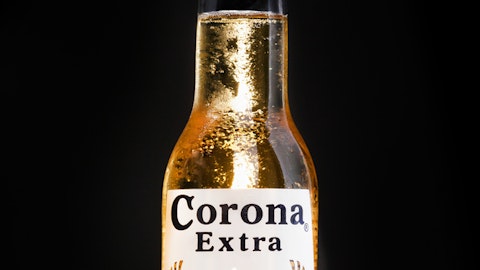Hedge funds and other investment firms run by legendary investors like Israel Englander and Ray Dalio are entrusted to manage billions of dollars of accredited investors’ money because they are without peer in the resources they use to identify the best investments for their chosen investment horizon. Moreover, they are more willing to invest a greater amount of their resources in small-cap stocks than big brokerage houses, and this is often where they generate their outperformance, which is why we pay particular attention to their best ideas in this space (see the details here). However, as investors cannot get enough of small-cap stocks in bull markets, this basket of stocks is also the first one to suffer from increased uncertainty and volatility. Nonetheless, hedge funds’ outperformance is not only limited to the small-cap space, considering that Goldman Sachs’ so-called VIP list (made up of the 50 most-owned stocks among hedge funds’ top ten holdings) outperformed the S&P 500 gauge on a quarterly basis 64% of the time from 2001 through 2015. That being said, let’s take a look at the hedge fund sentiment towards PepsiCo Inc. (NYSE:PEP).
PepsiCo Inc. (NYSE:PEP) was in 58 hedge funds’ portfolios at the end of December. PEP investors should pay attention to an increase in support from the world’s most elite money managers in recent months. There were 57 hedge funds in our database with PEP positions at the end of the previous quarter. At the end of this article we will also compare PEP to other stocks including Comcast Corporation (NASDAQ:CMCSA), Medtronic, Inc. (NYSE:MDT), and Cisco Systems, Inc. (NASDAQ:CSCO) to get a better sense of its popularity.
Follow Pepsico Inc (NASDAQ:PEP)
Follow Pepsico Inc (NASDAQ:PEP)
Receive real-time insider trading and news alerts
PepsiCo Inc. (NYSE:PEP) is not a beverage-only company like its main competitor in the beverage market, The Coca-Cola Co (NYSE:KO), in which 51 investors in our system were long on December 31, down by 3 quarter-over-quarter. PepsiCo rather is a global food and beverage company that has a wide portfolio of brands such as Frito-Lay, Pepsi-Cola, Tropicana and Quaker. In fact, the company’s snack food business and beverage business tend to act as complements to each other, which might represent a competitive edge over Coco-Cola and other competitors. Of course, PepsiCo’s beverage, food, and snack products are competing against products of other international beverage, food, and snack companies, so PepsiCo faces tough competition on multiple fronts. Nonetheless, the company has been successful in achieving strong organic growth in recent years despite facing extreme competition. By taking a quick glance at the company’s financial figures, one could come to the conclusion that PepsiCo Inc. (NYSE:PEP) is not doing great at the moment. For instance, PepsiCo’s total net revenue decreased to $63.06 billion in 2015 from $66.68 billion in 2014. However, one should keep in mind that the company’s non-U.S operations generated 44% of net revenue last year and that foreign exchange headwinds impacted PepsiCo’s net revenue growth by ten percentage points, mainly because of the Russian ruble, Venezuelan bolivar, Mexican peso, Euro, Brazilian real, and the Canadian dollar. For example, net revenue generated in Latin America decreased to $8.23 billion in 2015 from $9.43 billion registered a year ago due to 27% negative impact from unfavorable foreign exchange.
With all of this in mind, we’re going to review the recent action encompassing PepsiCo Inc. (NYSE:PEP), as well as look at several other aspects investors should consider when analyzing the company.
It is also important to note that in 2014, PepsiCo Inc. (NYSE:PEP) announced a target of reaching $5 billion in savings over the subsequent five years. The food and beverage giant already delivered roughly $3 billion in savings during the 2013 through 2015 period, and over $1 billion in savings in 2015 alone. Moreover, PepsiCo Inc. (NYSE:PEP) has paid quarterly cash dividends since 1965 and has increased its annualized dividend for 43 consecutive years, putting PepsiCo on track to join the hallowed list of Dividend Kings, which denote companies that have increased their annual dividend payments for more than 50 consecutive years. PepsiCo pays out an annualized dividend of $2.81 per share, which denotes a current dividend yield of 2.82%. The dividend payout ratio reached approximately 74% in 2015, which appears to be quite safe given the resilience of PepsiCo’s organic growth. The stock is priced at 19.84-times expected earnings, slightly below the forward P/E ratio of 20.30 for the Consumer Staples sector.
How are hedge funds trading PepsiCo Inc. (NYSE:PEP)?
At Q4’s end, a total of 58 of the hedge funds tracked by Insider Monkey were bullish on this stock, an increase of 2% from the third quarter. With the smart money’s positions undergoing their usual ebb and flow, there exists an “upper tier” of key hedge fund managers who were upping their stakes considerably (or had already accumulated large positions).
When looking at the institutional investors followed by Insider Monkey, Nelson Peltz’s Trian Partners has the most valuable position in PepsiCo, Inc. (NYSE:PEP), worth close to $1.83 billion, comprising 14.8% of its total 13F portfolio. The second largest stake is held by Yacktman Asset Management, managed by Donald Yacktman, which holds a $1.44 billion position; 10.9% of its 13F portfolio is allocated to the stock. Some other hedge funds and institutional investors with similar optimism contain Boykin Curry’s Eagle Capital Management, Ken Fisher’s Fisher Asset Management, and Cliff Asness’ AQR Capital Management.
As one would reasonably expect, specific money managers have jumped into PepsiCo Inc. (NYSE:PEP) headfirst. Millennium Management, managed by Israel Englander, assembled the most valuable position in PepsiCo Inc. (NYSE:PEP). Millennium Management had $72.9 million invested in the company at the end of the quarter. Matthew Tewksbury’s Stevens Capital Management also initiated a $14.5 million position during the quarter. The following funds were also among the new PEP investors: Michael Platt and William Reeves’ BlueCrest Capital Mgmt., David Costen Haley’s HBK Investments, and George Hall’s Clinton Group.
The final page of this article discusses the hedge fund activity in several other companies that have market capitalizations similar to PEP.
Let’s now review hedge fund activity in other stocks similar to PepsiCo Inc. (NYSE:PEP). We will take a look at Comcast Corporation (NASDAQ:CMCSA), Medtronic, Inc. (NYSE:MDT), Cisco Systems, Inc. (NASDAQ:CSCO), and Philip Morris International Inc. (NYSE:PM). This group of stocks’ market caps are closest to PEP’s market cap.
| Ticker | No of HFs with positions | Total Value of HF Positions (x1000) | Change in HF Position |
|---|---|---|---|
| CMCSA | 83 | 8778819 | 3 |
| MDT | 57 | 2103409 | -1 |
| CSCO | 60 | 4306020 | -7 |
| PM | 35 | 3025036 | -7 |
As you can see these stocks had an average of 59 hedge funds with bullish positions and the average amount invested in these stocks was $4.55 billion. That figure was $6.71 billion in PEP’s case. Comcast Corporation (NASDAQ:CMCSA) is the most popular stock in this table. On the other hand Philip Morris International Inc. (NYSE:PM) is the least popular one with only 35 bullish hedge fund positions. PepsiCo Inc. (NYSE:PEP) is not the least popular stock in this group but hedge fund interest is still slightly below average. This is a slightly negative signal and we’d rather spend our time researching stocks that hedge funds are piling on. In this regard CMCSA might be a better candidate to consider a long position in.
Disclosure: None




